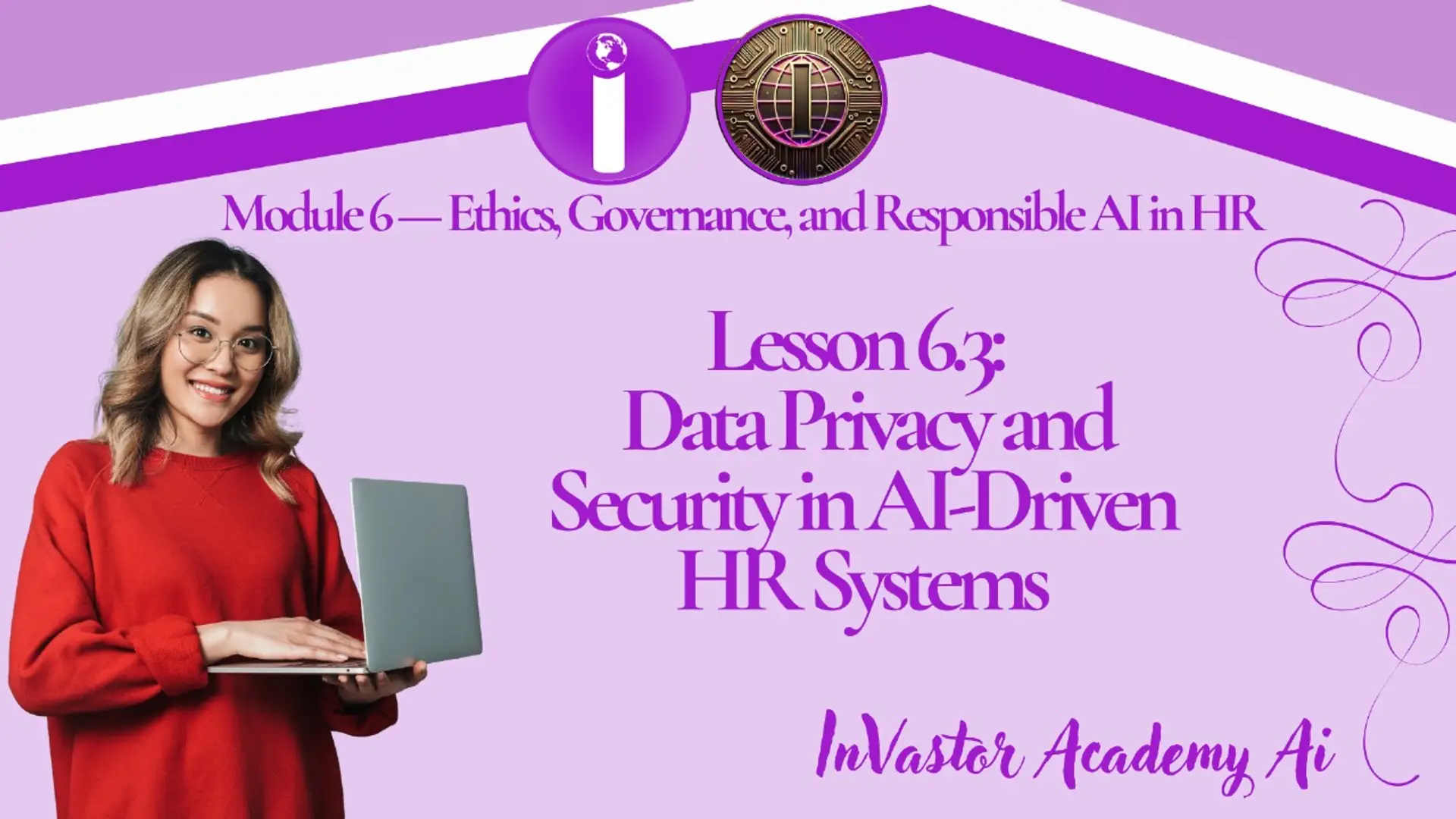

Lesson 6.3 — Data Privacy and Security in AI-Driven HR Systems
Module 6 — Ethics, Governance, and Responsible AI in HR
Lesson 6.3 — Data Privacy and Security in AI-Driven HR Systems
Learning Objectives
By the end of this lesson, learners will be able to:
- Understand the importance of data privacy and security in AI-driven HR systems.
- Identify key risks associated with managing employee data using AI tools.
- Examine best practices for protecting sensitive HR information.
- Evaluate compliance requirements under global privacy laws and frameworks.
- Apply responsible data management strategies in AI-enabled HR operations.
1️⃣ Introduction: Protecting People Data in the Age of AI
In today’s digital workplace, AI systems process vast amounts of employee data — from resumes and performance metrics to behavioral analytics.
While this enables smarter HR decisions, it also introduces new risks to privacy, data security, and employee trust.
Organizations must balance innovation with responsibility, ensuring that all AI applications comply with data protection standards and ethical norms.
Example:
A global company using AI to analyze employee productivity must ensure data is anonymized and securely stored to prevent misuse or unauthorized access.
2️⃣ Understanding Data Privacy in HR
Data privacy refers to an employee’s right to control how their personal data is collected, used, and shared.
AI-driven HR tools often gather sensitive information such as demographics, engagement levels, and behavioral data.
Key Privacy Principles:
Principle Description
Transparency Inform employees about what data is collected and how it’s used.
Consent Obtain explicit permission before using personal or biometric data.
Data Minimization Collect only what is necessary for a specific HR purpose.
Purpose Limitation Use data only for its stated objective, not for unrelated decisions.
Example:
An AI recruitment system should not use candidate data for marketing or unrelated analysis without consent.
3️⃣ Data Security in AI-Driven HR Systems
Data security ensures that employee data is protected from breaches, leaks, and cyberattacks.
Since HR data is often among the most confidential, securing it is a top organizational priority.
Best Practices for AI Data Security:
✅ Encryption: Secure all data transfers and storage using strong encryption methods.
✅ Access Controls: Limit data access to authorized personnel only.
✅ Regular Audits: Conduct security assessments and AI model audits.
✅ Anonymization: Remove personally identifiable information (PII) where possible.
✅ Incident Response Plans: Prepare protocols for data breaches or misuse.
Example:
IBM uses advanced encryption and role-based access controls in its AI HR systems to ensure sensitive employee data is never exposed.
4️⃣ Global Privacy Frameworks and Legal Standards
AI in HR must comply with international and national data protection laws.
Understanding these regulations ensures ethical and legal data handling.
Major Frameworks Include:
Law/Framework Region Key Focus
GDPR (General Data Protection Regulation) Europe Data consent, rights to access and deletion
CCPA (California Consumer Privacy Act) USA Employee data access and opt-out rights
PDPA (Personal Data Protection Act) Singapore Purpose limitation and data security obligations
Data Privacy Act of 2012 Philippines Fair collection, processing, and retention of personal data
Example:
Under GDPR, an employee can request access to their data or ask for its deletion if it’s no longer needed.
5️⃣ Ethical and Practical Challenges
⚠️ AI Bias and Misuse: Algorithms may unintentionally reveal private data through biased predictions.
⚠️ Data Ownership: Unclear ownership of AI-generated insights can cause legal and ethical disputes.
⚠️ Informed Consent: Employees may not fully understand how their data feeds into AI systems.
⚠️ Cross-Border Data Transfers: Global HR systems often process data across countries with varying laws.
Example:
If an AI tool predicts turnover risk based on engagement data, the analysis must not expose personal details or unfairly target employees.
6️⃣ Responsible Data Management in HR
To maintain trust and compliance, organizations must adopt responsible data management practices.
Key Steps:
✅ Implement Privacy-by-Design in AI systems from the start.
✅ Train HR teams on data ethics and compliance standards.
✅ Communicate clearly with employees about data usage and AI monitoring.
✅ Use bias detection tools to ensure fairness in AI decisions.
✅ Collaborate with IT and Legal departments for ongoing governance.
Example:
Microsoft integrates Privacy Impact Assessments (PIAs) into every new AI HR tool before deployment.
7️⃣ Practical Activity
Task:
Design a Data Privacy and Security Plan for an AI-powered HR platform (e.g., recruitment or performance analytics).
Include:
- Types of employee data collected
- Measures to protect data security
- Compliance requirements (GDPR, Data Privacy Act, etc.)
- Communication strategies to ensure transparency and consent
8️⃣ Supplementary Resources
- 🎥 “AI, Data Privacy, and Employee Trust” — SHRM Learning Series
- 🎥 “Data Governance in AI-Powered HR Systems” — Deloitte Insights
- 🎥 “GDPR and HR: Managing Employee Data Responsibly” — CIPD Learning
- 🎥 “Cybersecurity Best Practices for HR Professionals” — IBM Security Series
Lesson Quiz 6.3
Please complete this quiz to check your understanding of the lesson. You must score at least 70% to pass this lesson quiz. This quiz counts toward your final certification progress.
Answer the quiz using the Google Form below.
Click here for Quiz 6.3
Conclusion
AI-driven HR systems can revolutionize talent management — but only if data privacy and security remain top priorities.
By embedding ethical data practices, organizations can strengthen employee trust and ensure compliance while harnessing the full power of AI.
💡 “Data is powerful, but only when it’s protected and respected.”
📘 Next Lesson: Lesson 6.4 — Building a Responsible AI Governance Framework in HR
📘 Previous Lesson: Lesson 6.2 — Global Frameworks and Legal Standards for Ethical AI in HR
📘 Course Outline: Module 6 — Ethics, Governance, and Responsible AI in HR
Related Posts
© 2025 Invastor. All Rights Reserved

User Comments